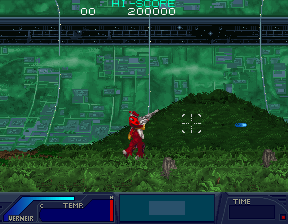Finest Hour (arcade game)
| Finest Hour | |
|---|---|
|
Screenshot | |
| Developer(s) | Namco |
| Publisher(s) | Namco |
| Designer(s) | N. Abe |
| Composer(s) | Katsuro Tajima |
| Platform(s) | Arcade |
| Release date(s) |
Arcade |
| Genre(s) | Run and gun |
| Mode(s) | Up to 2 players, alternating turns |
| Cabinet | Upright, cabaret, and cocktail |
| Arcade system | Namco System 2 |
| CPU |
2x Motorola 68000 @ 12.288 MHz, 1x Motorola M6809 @ 3.072 MHz, 1x Hitachi HD63705 @ 2.048 MHz |
| Sound |
1x Yamaha YM2151 @ 3.57958 MHz, 1x C140 @ 21.39 kHz |
| Display | Horizontal orientation, Raster, 288 x 224 resolution |
Finest Hour (ファイネストアワー Fainesuto Awā) is a run and gun arcade game released by Namco in 1989 (only in Japan); it runs on Namco System 2 hardware. It was later rereleased on the Wii Virtual Console on August 25, 2009.
Gameplay
The player must take control of a Transformer-like battlemech known as Sygnus (シグナス Shigunasu), who is equipped with a laser cannon, Vernier (misspelled as "Verneir") jump-jets, auto-targeting, and an automatic cooling system; much like in Namco's own Mirai Ninja (which also runs upon their System 2 hardware), pushing that joystick twice in the same direction will make Sygnus switch from a march to a dash while he is moving, and the player may not make him change the direction that he is facing in mid-air. However, unlike that aforementioned Mirai Ninja, he has no "life meter", just a temperature meter which increases when he is hit, and decreases when he is not hit - but, if the timer should run out, his cooling device will break (indicated by the text of "COOLING DEVICE BROKEN" at the bottom of the screen). And if he should overheat (which usually happens when there are too many enemies firing at him at once), the game will immediately be over (as six texts about impossible continuation appear on the screen and he explodes); the game is composed of four stages which must be finished twice (like in Namco's own Rolling Thunder), and are all named after songs by the rock band Rush: "Middletown Dreams", "Distant Early Warning", "Subdivisions", and "Grace Under Pressure".
References
- ↑ "System 2 Hardware". System 16. Retrieved 2007-10-08.
